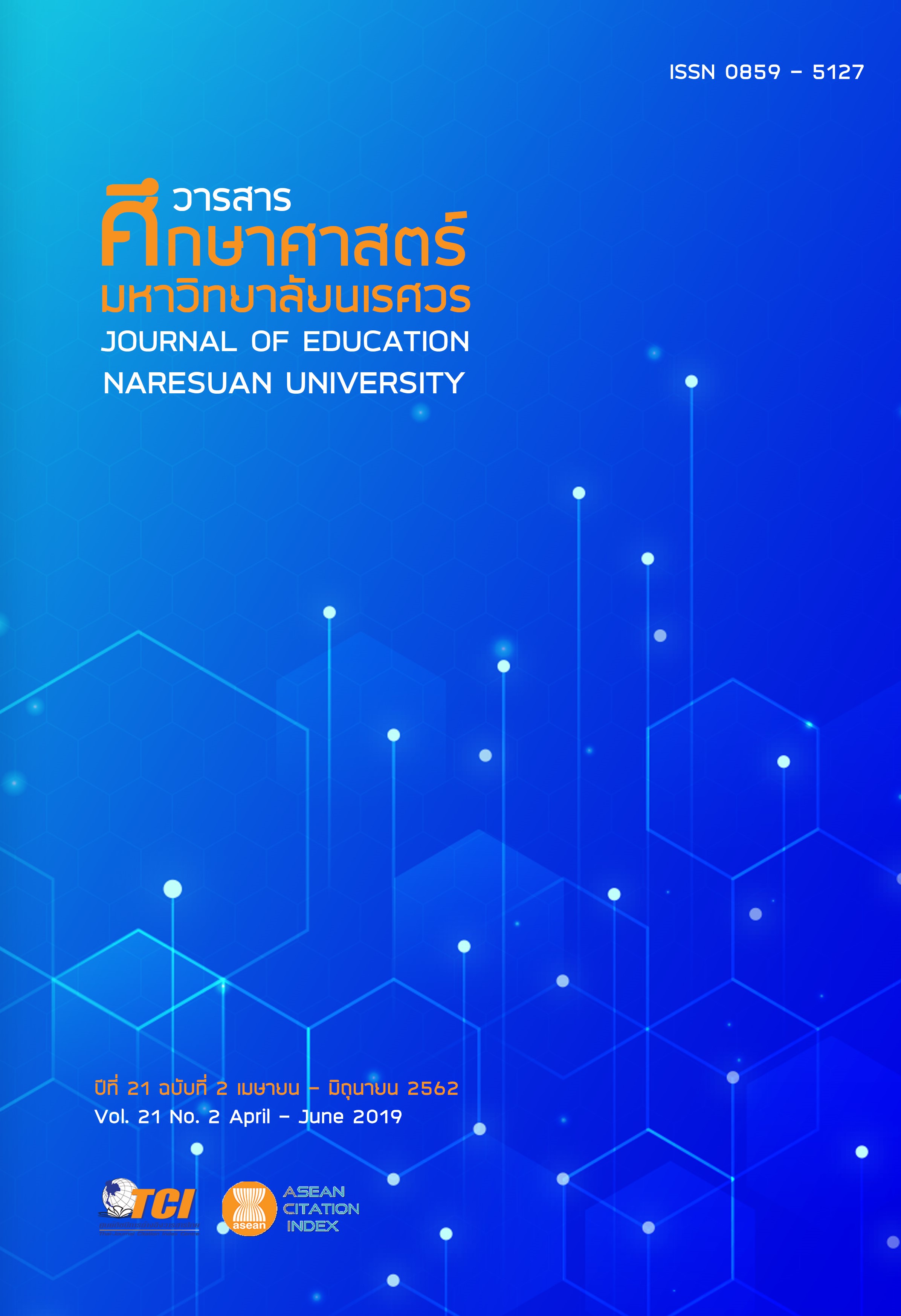การพัฒนาการคิดอย่างเป็นระบบสำหรับนักเรียนชั้นมัธยมศึกษาปีที่ 4 เรื่อง ระบบประสาทและอวัยวะรับความรู้สึก โดยใช้การจัดการเรียนรู้แบบจำลองเป็นฐาน (DEVELOPING OF SYSTEM THINKING FOR MATTAYOMSUKSA 4 STUDENTS IN NERVOUS SYSTEM AND SENSORY ORGANS THROUGH MODEL-BASED LEARNING)
Main Article Content
Abstract
การวิจัยเชิงปฏิบัติการครั้งนี้มีเป้าหมายเพื่อ 1) ศึกษาแนวทางในการจัดการเรียนรู้โดยใช้แบบจำลองเป็นฐานเพื่อพัฒนาการคิดอย่างเป็นระบบ และ 2) ศึกษาผลการพัฒนาการคิดอย่างเป็นระบบภายหลังการจัดการเรียนรู้ กลุ่มเป้าหมายคือ นักเรียนชั้นมัธยมศึกษาปีที่ 4 ห้องเรียนพิเศษวิทยาศาสตร์ ในโรงเรียนขนาดใหญ่แห่งหนึ่ง จำนวน 27 คน โดยการเลือกแบบเจาะจง เครื่องมือที่ใช้ในการวิจัยประกอบด้วย แบบสะท้อนการจัดการเรียนรู้ ในแต่ละแผนการจัดการเรียนรู้โดยใช้แบบจำลองเป็นฐานเพื่อพัฒนาการคิดอย่างเป็นระบบ เรื่อง ระบบประสาทและอวัยวะรับความรู้สึก และแบบจำลองระบบ เรื่อง ระบบประสาทและอวัยวะรับความรู้สึก ผลการวิจัย พบว่า
1. แนวทางการจัดการเรียนรู้โดยใช้แบบจำลองเป็นฐาน เริ่มจากการทำความเข้าใจและระบุองค์ประกอบผ่านการสังเกตสื่อที่ครูกำหนด การพัฒนาแบบจำลองอย่างง่าย จากผลการสังเกตองค์ประกอบของระบบ การพัฒนาแบบจำลอง 2 มิติของกลุ่มให้สมบูรณ์โดยใช้ข้อมูลจากแบบจำลองอย่างง่ายของสมาชิกในกลุ่ม การนำแบบจำลอง 2 มิติ มาใช้อธิบายสถานการณ์ที่กำหนด และการสร้างแบบจำลองระบบเพื่ออธิบายสถานการณ์ใหม่
2. ผลการพัฒนาการคิดอย่างเป็นระบบในด้านการระบุองค์ประกอบและความสัมพันธ์ในระดับชีวภาพเดียวกันในระดับดีมาก การเชื่อมโยงความสัมพันธ์ต่างระดับทางชีวภาพและการอธิบายปรากฎการณ์ทางชีววิทยาด้วยแบบจำลองอยู่ในระดับดี ส่งผลให้นักเรียนมีภาพรวมการคิดอย่างเป็นระบบอยู่ในระดับดีมาก
DEVELOPING OF SYSTEM THINKING FOR MATTAYOMSUKSA 4 STUDENTS IN NERVOUS SYSTEM AND SENSORY ORGANS THROUGH MODEL-BASED LEARNING
This action research aims to 1) study about how to use model-based leaning management to develop the systems thinking in nervous system and sensory organs lesson and 2) study about systems thinking of student after using model-based learning management. The target group of this study is Mattayomsuksa 4 students that study in enrichment science classroom. The research tools were used 1) Four learning management plans that using model-based leaning to develop systems thinking in nerve system and sensory organs lesson, 2) reflecting form of learning management, and 3) the system modeling. The results are;
1. The model-based leaning management begin at; Explain the system components that student recognize by learning medias. Then, Student develops a simple model by using components that observed. Next, Students develop a general 2D model that using student group to compare their simple models to develop group 2-D model. After that, Application of systems thinking which use the group model to explain biology phenomena. Last, Application of the hierarchical systems model by generate system model to explain new biology phenomena.
2. After learning management, the students’systems thinking is in good level.
Article Details
The owner of the article does not copy or violate any of its copyright. If any copyright infringement occurs or prosecution, in any case, the Editorial Board is not involved in all the rights to the owner of the article to be performed.
References
2. Coll, R. K., & Taylor, I. (2005). The role of models and analogies in science education. International Journal of Science Education, 27(2), 183–198.
3. Evagorou, M., Korfiatis, K., Nicolaou, C., & Constantinou. C. (2009). An investigation of the potential of interactive simulations for developing system thinking skills in elementary school: A case study with fifth graders and sixth graders. International Journal of Science Education, 31(5), 655–74.
4. Kijkuakul, S. (2015). 21st Century Learning in Science. Pitsanulok: Faculty of Education, Naresuan University. [in Thai]
5. Najang, K., & Kaewdee, W. (2014). Effects of using model-centered instruction sequence on ability in making scientific model and concepts of laws of motion and types of motion of upper secondary school students. An Online Journal of Education, 7(1), 1830 – 1844. [in Thai]
6. Srikrod, C., Srisawat, C., Panprueksa, K., & Prasopkittikun, T. (2016). The effect of 5E inquiry learning cycle model and mind mapping technique on “Nervous system and sensory organ” for 11th grade students. Journal of Education Naresuan University, 18(2), 171 – 180. [in Thai]
7. Supatchaiwong, P., Faikhamta, C., & Suwanruji, P. (2015). Using model-based learning for enhancing mental model of atomic structure and understandings of the nature of model of 10th grade students. Journal of Learning Innovations Walailak University. 1(1), 97-124. [in Thai]
8. Verhoeff, R. P., Waarlo, A. J. & Boersma, K. T. (2008). Systems modelling and the development of coherent understanding of cell biology. International Journal of Science Education, 30(4), 543–568.


